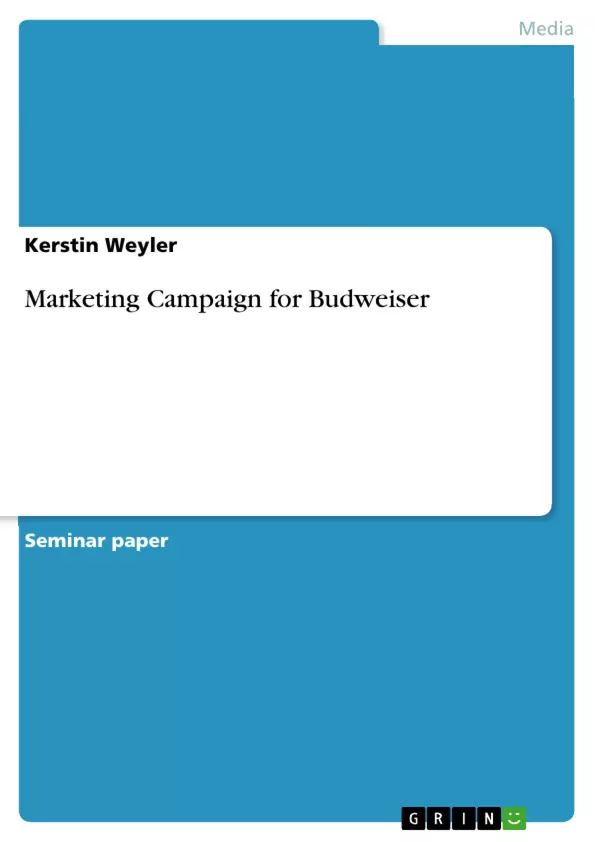One of the reasons for choosing to analyse the company Anheuser-Busch with its brand family Budweiser lies in the fact that every group member already had experience in writing reports about relatively “small” (European) companies and therefore preferred analysing the largest beer brewer in the world. The group consisted of 5 people from different countries (Sweden, Austria, Germany and Holland) who came to England with the European Erasmus programme. The work as a team has been helpful and challenging, in fact the cultural differences have helped providing the group with different point of views and interesting information from the own background. The report contains the following key-points in order to give a comprehensible structure and consequently a good analysis of the company Budweiser: · Situation Analysis · Marketing Analysis · Recommendations The situation analysis gives an internal and external view of the chosen company and provides the reader with a general knowledge to understand the marketing analysis and the following recommendations. As the language knowledge might not be at the same level of other English students the group members excuse themselves and hope that the ideas will nevertheless be understandable.
Table of Contents
- I. Introduction
- II. Situation Analysis
- 1. Historical Background of Anheuser-Busch
- 2. Sector and Size
- 3. Brands
- 4. Services
- 5. Competitors
- 5.1 Market Share of the Top 3 Brewers in the United States
- 5.2 Market share of the four Budweiser brands
- III. Marketing Analysis
- 1. Customer Analysis
- 1.1 Customer Profile
- 1.2 Customer Buying Behaviour
- 2. Marketing Environment
- 2.1 Social Forces
- 2.2 Technological Forces
- 2.3 Economical Forces
- 2.4 Political Forces
- 3. Marketing plan
- 3.1 Mission Statement & Marketing objectives
- 3.2 Marketing Strategy
- 4. The four P's
- 4.1 Product
- 4.1.1 Product Life Cycle
- 4.1.2 Packaging & Corporate Identity
- 4.1.3 Branding
- 4.2 Price
- 4.3 Place & Distribution
- 4.4 Promotion mix
- 4.4.1 Advertising
- 4.4.2 Public Relations & Sponsorship
- 4.4.3 Personal selling
- 4.4.4 Sales promotion
- IV. Recommendations
- 1. Product Portfolio & Objectives
- 2. Communication to Retailers
- 3. Communication to Customers
- 4. Further recommendations
- 5. Evaluation
Objectives and Key Themes
This report aims to provide a comprehensive analysis of the Anheuser-Busch company and its Budweiser brand family. The report delves into the company's historical background, its position in the market, its brand portfolio, and its marketing strategies. It also explores the company's competitive landscape and its efforts to engage consumers.
- Historical Development of Anheuser-Busch
- Market Position and Competition in the Beer Industry
- Brand Portfolio and Marketing Strategies
- Customer Analysis and Marketing Environment
- Recommendations for Future Success
Chapter Summaries
- I. Introduction: Introduces the report's focus on analyzing Anheuser-Busch and its Budweiser brand family, highlighting the group's diversity and the importance of understanding the company's internal and external perspectives.
- II. Situation Analysis: Provides a detailed overview of Anheuser-Busch's historical background, its market share, and its brand portfolio. It also examines the company's competitors and their market positions, including the top three brewers in the United States.
- III. Marketing Analysis: Explores the company's customer profile, buying behavior, and the marketing environment in which it operates. It also delves into the company's marketing plan, including its mission statement, objectives, and strategies, as well as its approach to the "four P's" of marketing.
- IV. Recommendations: Offers suggestions for improving Anheuser-Busch's product portfolio, communication with retailers and customers, and overall strategies for future success.
Keywords
Key terms and concepts explored in this report include Anheuser-Busch, Budweiser, beer industry, market share, brand portfolio, marketing strategies, customer analysis, marketing environment, competition, and recommendations for future success. The report also examines relevant themes such as historical development, brand management, market position, and consumer engagement.
- Quote paper
- Kerstin Weyler (Author), 2000, Marketing Campaign for Budweiser, Munich, GRIN Verlag, https://www.grin.com/document/37877



